#i need to like look up scene structure and apply it to some examples
Explore tagged Tumblr posts
Text
maybe i just don’t follow enough about the fanfiction community anymore but… i feel like plot and story, and actually making scenes make sense and have structure and purpose, is harder to get write than even other things about writing that i consider hard—like having consistent, relevant pacing and creating natural-sounding, in-character dialogue.
and from what i’ve seen, it’s like no one ever talks about improving this major overarching skill, when compared to how much as they talk about minute and minor details to improve with your writing, like the vocab you use.
and maybe fanfiction is uniquely challenged here because the point of it (if the source material is decent, anyways) is supposed to be that it’s not necessary, and is often without a serious purpose and written without structure.
my interpretation of it is that the core of writing (which is giving your readers a reason to read) is assumed to be already accomplished when you write fanfiction—because it’s fanfiction—but this is often to the detriment of the writing, no matter if it’s fanfiction or not, because writing needs that purpose to exist.
#i’m sorry because this sounds really cringey because i’m barely doing anything with this anyways it’s literally a small jokepost of a fic#but literally every time i write one word of fic i start thinking about The Process Of Writing and i think too much about it for my own goo#so don’t take this as complaining i’m just thinking out loud#but this is my greatest challenge and i think it—along with pacing wnd character voice—is actually what really separates fic from source#because when i write fic i typically have copies of the books pulled up in another window and i go back and forth#to create some kind of consistency by referencing (like you might when drawing)#but the one thing i can never get right (or it takes me many edits) is actually making the scene feel like it is necessary#and worthy of the reader’s time and attention#like i don’t think my actual writing is bad but i just feel like everything goes on for too long and simultaneously goes nowhere#and that’s such a big issue that can’t be fixed by editing sentence structure or switching out words.#it’s the structure of a work which is really challenging and important to get right and yet i see little advice and motivation around it#as opposed to like ‘50 different words to use instead of these same boring words’#dude no one cares if you said ‘said’ a bunch. what matters is where is this going anyways#i know the way to improve is to read but i am just talking inbetween making this really small thing#so again. dont take me talking a lot here as me freaking out. i just have thoughts about this but nowhere to put them#like it’s funny to me because i write something and the dialogue makes sense but the whole thing feels Boneless LOL#i need to like look up scene structure and apply it to some examples#the elbow-high diaries
10 notes
·
View notes
Note
Hello I really love your work and was wondering how long it took U to get this many followers cause I don't have many and I want to get better at writing cause I have loads in my drafts but I don't think that they are that good so I was wondering if U had any tips on writing and how to get more ppl to see your work thank U sm 🤪
okay so im sure this is irritating to here but i am not worried about followers! i have been in the past and it makes writing miserable for me. i obsess over stats. engagement is good -- i love attention, you love attention, we all love attention, and being told our work is good is a motivating thing to hear -- but obsessing over follower count Will make writing hard for you. i pinky promise.
as for improving on writing, i have some more solid advice for you:
PRACTICE. write every day, even if its shit, even if its 50 words, even if it never leaves your notes app. write.
switch writing mediums if you're struggling. when i have writers block on my phone i switch to google docs. when i struggle there i switch to tumblr drafts. then to instagram DMs. then to a random notebook website. then to the fucking search bar of google. to physical paper. to comments on long-dead youtube video. to my actual wall with pencil. to the dirt outside. i write EVERYWHERE. putting my thoughts in new physical spaces helps crack me out of the block every time. so do weird constraints like character limits or a pen that's running out of ink. switch shit up and apply light pressure.
read with the intention of learning. that means actual writers craft books, or reading work you admire with a close lense.
analysis!!! to build off the last point, when you read something that is profound, or makes you feel something, STOP -- take the time to feel it, to love it, then tear it apart. what actions is it describing? how do you know? what emotions do the actions provoke? what references are made, and why does that matter? what objects are present? what do they signify? how can you tell? you need to do LITERARY ANALYSIS. you cannot learn to write without learning to read. (this is called 'close reading analysis'. if you want some help practicing, let me know. i'll show you a couple examples.)
critically read your own writing. what is strongest? what do you do well? what needs more practice, and what exercises can you do to get that practice?
write what you enjoy. this is why i cannot and will not do commissions -- they suck the fuckin' life outta me. as soon as someone tells me what to do it stops being fun. i write things as they pop into my head bc that's what i enjoy doing.
use prompts. I DO. it is so helpful. can't think of a goddamn thing to write? look up a dialogue prop. find a song, use it as a plot background. rewrite an existing scene. you know how artists trace to practice their skills? put a scene in your own words, that's the writing equivalent.
go on walks and space the fuck out. when im low on ideas, or i cant get myself to focus, i put on headphones and wander around the neighbourhood. my brain goes off wherever it goes and i let it. it usually returns with an idea or five.
practice no-phone time. boredom is the boat of creativity. stare at a wall, pull weeds, doodle, pace, whatever you need to do to get your brain whining about needing your phone in front of your face, because if you ignore that long enough the ideas WILL come and they will come in swathes.
study film as well as literature. ive talked about it a little bit before (here) but learning how the camera and audience are intrinsically linked to a story will help you learn how to pace and structure it.
i have other stuff but that's a good list i think! some of my other writing advice is linked here, here, and here. good luck!
#lowkey been thinking of starting a blog specifically for writing advice and workshopping stuff#as in yall send me asks with your works and i help out#or helping with lit analysis#etc etc#thoughts??#ask#writing advice
30 notes
·
View notes
Text
A.N.I.M. Patreon Rewards March 6th 2025
This one is a short changelog for Eureka: Investigative Urban Fantasy and a very big one for Silk & Dagger: A Sensible Drow RPG, because we just released a big public beta update for Eureka on itch.io, and a Silk & Dagger is set to release in public alpha on itch.io on March 10th, next week, so I have been putting a lot of work into it.
Silk & Dagger is currently only available on our patreon at the time of writing this, but will be releasing in its alpha state on March 10th, 2025. (That's just a few days.)
Both changelogs below.
Eureka: investigative Urban Fantasy changelog
Copy-editing Progress: Thoroughly copy-edited up to p. 330.
We also released Eureka adventure modules “The Eye of Neptune” and “FORIVA: The Angel Game” into free beta on itch.io. Scroll up to find the link and a game jam!
WHOLE BOOK
CHAPTER 1
Alright alright we’ll put the examples of play back in at some point but we will need to simplify and rewrite them a bit.
Many small clarifications and typo fixes
CHAPTER 2
Many small clarifications and typo fixes
Made Kleptomaniac Trait also give a bonus to Pickpocketing
CHAPTER 3
Many small clarifications and typo fixes
CHAPTER 7
Heavy copy-editing on the first few sections
CHAPTER 8
Silk & Dagger changelog
CHAPTER 1
Made Complications from tasks twice as likely to happen by default, now that the palace upgrade system allows for getting many bonuses to these rolls.
Added rough rules for skirmishes.
Fixed many typos
Wrote out “Players Are Not Their Characters” section
Wrote out “Third-Person Verbiage” section
Wrote out “Character vs Character, not Player vs Player” section
Wrote out “No Excuse for Bad Faith Play” section
Wrote out “Be Prepared to Lose” section
Wrote out “Losing” and “Winning” Sections
Wrote out “Role of the Narrator” section
Wrote out “Role of the PCs” section
Added a way for PCs to gain Favor Points by pointing out the failures of Drow
Mistresses can now also use Boons to restore lost Reputation.
Wrote out “What Does a Session Look Like?”
Wrote out “When to Make a Roll”
Wrote out “What is a Scene?”
Wrote out “Timekeeping” and other sections related to Sands and Hourglasses.
Wrote out “How to Make a Roll”
Wrote out “Modifiers”
Wrote out “Consequences and Degrees of Success”
Wrote out “Assistance Rolls”
Wrote out “Expect to Fail Rolls”
Made it so that the Narrator also gets a Favor Point every time the Spider Goddess does.
Added “Impressing Other Drow” section
Added more about Traversing the Tunnels and made it its own section, saying how it works in gameplay that servants can easily get lost in the tunnels.
CHAPTER 2
Added rules for palace generation and generation of the tunnels surrounding the palace.
Added extrabodily powers and instructions for how they apply in character creation.
Added that the steps involved in the creation of the tunnel system surrounding the palace are not to be seen by players of the servants or Spider Goddess.
Added actual rules for how to determine a Drow PC’s starting Reputation.
Added modifiers relevant to a PC’s sex and race.
Clarified that the Flame extrabodily power does not allow the elf to control fire, just produce it.
Added a series of tables for generating elves.
Revamped some parts of the palace creation rules and made it so that most upgrades have requirements of width, height, and length instead of just ceiling height.
Wrote out step-by-step character creation rules
Added Good at Following Orders Trait
CHAPTER 3
Added a little more info about skirmishes.
Added a little more info about sex and race in the society of the pit.
Added more info on how residents of the pit perceive their societal structure
CHAPTER 4
Added Epilogue tables
#eureka: investigative urban fantasy#eureka#eureka ttrpg#silk & dagger#silk & dagger: a sensible drow rpg#silk & dagger ttrpg#indie ttrpg#rpg#ttrpg#ttrpg community#ttrpg tumblr#tabletop#ttrpgs#drow
18 notes
·
View notes
Text

I wanted to give a little bit of background on my writing process behind Tooth & Nail, and als Penumbra!
The Base idea
T&N started out as a D&D campaign, set in a modern day zombie outbreak, plus D&D magic, back in ye olden days before I understood that other TTRPG systems exist. It evolved into a campaign idea for VTM after I got into it, but I never managed to actually realize it. Then later, I started telling a zombie story under that same name with strictly human sims, and later decided to go back to VTM + zombies... and here we are.
Penumbra is a little more complicated. The origin of the lore is in how I started developing my regular gameplay save's lore, explaining why most of my sims are berry, and why they have occult elements without actually being occults. That turned into proximity magic radiation from the fey that change a regular sim's genetics into the Feytouched. And then I started adding lore onto it. Penumbra, the world, started with a royalty collab in the Berry Storyteller's Guild that sadly never really saw the light of day. I let myself be inspired by Kingdoms of Amalur, and the conflict between Seelie and Unseelie, with that melancholic memory of a better time, when the courts were friendly to each toher. Penumbra's first iteration had the same characters, but very different. The central conflict played out between Umbrae and Dreamdust, with them eventually knocking each other into a coma, and leaving their Children to navigate the issue. The Consorts, as well as the two Crown Princesses played relatively minor roles, and Blackwood was actually just a spoiled brat that occasionally got into Nocturne's way.
I completely reworked it for the actual story i ended up writing.
The Process
I usually start with a very broad, base Idea. Penumbra already had some baggage, from its previous iteration, but with T&N, I just went "I want a young vampire and a human sibling". I kind of wing it throughout CAS, and just see what vibes the character gives me - For example, Amias' usually reserved nature is mainly because I decided to dress him very formally, starting out, while Cara's more laid back narration (and her swearing, actually) comes from me deciding to give her a vague alt-aesthetic.
Other characters, I went in relatively blank, too. I wrote down what Clans would have a primogen in this city, and just made a Sim that looked cool. Exceptions apply, such as my Salubri primogen having control over the Tremere too, but I initially had Iofel be a very kind person - he even has the goddamn Generous trait! I'd later decide to subvert and complicate that, as you can read in his journey.
Then, when I have everyone, I typically begin by writing a prologue to set the scene, and leave the game again.
I outline major story beats, and storyboard important scenes, in writing, I'm not an artist (lol). Back to the game, and I start going through the poses that I have, and the poses that I need, make a list, and go scour the internet for what I'm missing. (Searchable Pose Player has saved my sanity fr)
I usually "write" the story as I take my screenshots, trying out poses and sets as I go. Such as, the scene where Husam decides to sleep on the bathroom floor was brought on by some floor sleeping poses I found! Same thing for the dialogue scene on the porch... I found some poses for leaning and sitting on a fence.
Some character dynamics are also entirely spontaneous. I like to say that the characters decided that, not me. Like, Iofel and Medea being friends was completely out of the blue for me. Rosa and Medea being romantically involved was, too. Chase and Amaranda being close came on by my structure of the chapter - each character got a little segment, of where they are post evacuation, and I decided on the fly that they'd go together.
Once I have my screenshots, I crop and (minorly) edit them (I use Photoscape Pro), and then open up my post editor and get to work. I filter out screenshots as I work, because sometimes, I don't need 57 reaction shots of the same character, and just pick the best one.
Format, tag, and post.
Afterward, I usually copypaste and post my updates in two sims discord servers I'm in, and if I finish a chapter, i also painstakingly post it in my forum thread on MTS.
Then, it's usually a few days of gathering inspiration, until i start working on the next batch of story posts.
Resources I use
TMEX Searchable Pose player
@occult-cc-finds
@ts4-poses
Spinningplumbob's Fairies vs. Witches mod, which i used heavily in Penumbra
And, I use @losieee 's Fledgling Gshade preset, which was modeled after VTM:bloodlines. I also use some of their buiids, Like the Arcade Medea and Rosa hide out in, which is also a location from VTMB, as well as Medea's safehouse she carted Iofel off to I also have Club Asylum in that save, but I haven't gotten to use it yet
If you like my writing consider tipping me on kofi <3
10 notes
·
View notes
Text
Writing advice for myself (after finishing my first long fic)
A few months ago, back on May 24th, I saw Furiosa for the first time and lost my fucking mind. It had been a while since I had spent much time in fandom creative spaces, but when I saw Praetorian Jack swing across the door of the War Rig in front of Furiosa and say the words "You can speak to me," my first thought was "I need to read some fanfic about these two immediately."
Of course, because the film had literally just come out, there wasn't very much on offer yet. I was sure that many talented fanfic writers were frantically typing away, but I could not wait. "Fuck it," I thought. "I'll write my own."
I hadn't written any fanfic since I was a tween, but a week later, I had published a 5,000-word one-shot. And because I had so much fun writing that, I immediately started another fic. It was going to be shorter, just one scene of Furiosa and Jack having a conversation. So I wrote that, and then I thought about some other conversations they might have, and then I wrote a few more scenes, and then things got out of hand and I ended up with 74,000 words.
So that one scene turned into Night Watch, which is currently updating twice a week:
I definitely did not set out to write anything this long, and I am both shocked that I managed it and also pretty proud of myself! But I also learned a lot during this process. I've had a few cracks at writing non-fanfic novels in the past and they always fell apart pretty quickly. But now I am pretty much addicted to writing. It consumes my life. It is a problem.
As soon as I finished writing Night Watch, I immediately moved on to starting another fic. So before I get too far into that, I thought I'd write up some of the things I learned about writing, and then hopefully I can continue to apply them. If nothing else, the navel-gazing will be useful to me (and maybe to other people too?)
All this advice is probably pretty basic. I stand on the shoulders of giants (some of whom have very active AO3 accounts).
Plot structure
I did not start out by doing any planning at all, but when I was about 15,000 words in, the fic started to get unruly. I had a bunch of individual scenes that I liked, and I wanted to connect them together, but I had no idea how to do that in a way that felt satisfying.
At this point I took a step back and did some light reading about narrative structure. Some of these frameworks are more popular than others, like the famous Joseph Campbell monomyth or the Save the Cat beat sheet. Because romance was a central focus, I also looked at some structures specific to romance novels. While the events of a heroic adventure are pretty different to an emotional romance, they do still have certain things in common: rising and falling tensions, increasing stakes, moments of defeat and triumph (whether that's punching an enemy in the face or kissing the hot War Rig driver).
My attitude towards these frameworks was to treat them more as rough guidelines than specific metrics to aim for. While I'm not trying to write to fit a formula, having a broader idea of the pacing was extremely helpful for mapping out the overall structure of the work. I could see where my scenes might fit into the rhythms of the story, and also what gaps I'd need to fill. This is what led me to introduce some recurring external antagonists so the conflict wasn't confined to the characters' heads (although there is plenty of that too).
Narrative arcs
At this point, I had a rough plot mapped out. I had some protagonists, I had some antagonists, and I knew where they were starting and where I wanted them to finish. While I might not have worked out every single plot point, I did know what story beats I wanted to hit and where – wanting to introduce new conflicts at certain points in the story, for example. Then I worked out what events could hit those beats when I got to them.
This approach got me through the first draft. I had written over 60,000 words! I was done! Hooray!
Then I sat back and re-read the whole thing from start to finish and noticed all the places where the narrative was unsatisfying. The individual scenes might have been good, but something was off about the way they fit together.
At this point I took a step back and did some more thinking about the individual story arcs – the smaller stories within the broader narrative that make it satisfying. Plot on its own is just stuff happening. Narrative arcs are what give that stuff an emotional punch.
I ended up definining a few different kinds of arc:
Protagonist development – How do the main characters change and grow over the course of the story? What actions and emotional steps do they need to take to get there? While characters develop in complex ways, I picked one or two core themes per protagonist, like "trust" and "hope", and centered the progression around that.
Romance – How does the relationship between the characters develop? When do they catch feelings? What challenges do they have to overcome before they can act on their connection? (Probably ones related to their internal arcs, it turns out.)
Side characters – I ended up picking three side characters who I wanted to develop throughout the story. How do they change? How does their relationship with the protagonists change?
Antagonists – What do the bad guys want? How do they mess things up for our protagonists? How do they raise the stakes of the conflict?
Once I'd defined the arcs I wanted to have, I wrote out the different beats each arc would need. Some of these arcs were very shallow (Side Character A learns to do X) and others were a lot more detailed. Then I looked at the draft I'd written and identified which beats I was hitting and which ones I was missing.
Being able to map these arcs onto the overall narrative was a huge lightbulb moment for me. I went through the fic section by section and labelled which arcs the section applied to. This helped me to check the pacing of the individual arcs and see where I might need to add an extra paragraph or scene to beef them up.
Also, if a completed section wasn't contributing to any of these arcs... I rewrote it or got rid of it. In some cases, this was painful, but I think it made the resulting work a lot tighter. Everything should have a purpose.
Going through this process also helped me to see the intersections between the different arcs. It's really satisfying when two different plot threads come together, or when a character's internal development enables them to take on an external conflict. Some of my favourite moments in the story ended up coming from creating these connections, and they wouldn't have happened if I hadn't thought about the individual arcs.
When to post
Once I realised that Night Watch was well into multi-chapter territory, I had to decide whether or not to publish as I went along, or wait until I'd finished the whole thing.
Publishing chapter-by-chapter was pretty tempting – I was hungry for those sweet kudos and comments. But ultimately, I decided to wait to publish until I had finished writing.
This turned out to be a better fit for my own writing process. Empty pages are the hardest thing for me, so I try to just get stuff on the page as quickly as possible and then come back to tidy up later. I did end up making pretty substantial changes to the structure of the plot in my second draft, and doing that might have been more awkward if I'd already been posting.
Also, I figured that I wouldn't have to stress out about updating regularly if I already had all my chapters lined up and ready to go.
Other random stuff that helped
After finishing my first draft, I went back and wrote a summary of each chapter. This was really useful for checking the pacing of the story and seeing if there were any bits left out.
Scrivener is an incredibly useful app for writing and well worth the money if you can afford it.
I had a hard time working out how to write my antagonists until I wrote up a bunch of lore and biographies, purely as a reference. Even though most of it never came up, it did inform my choices about what they should do and how they would react to the events.
Asking myself "what changes during this scene?" often got me unstuck when I wasn't sure what to write. Whether that's a critical fight scene or a character's perspective on a situation shifting, change is often what gives a scene a reason for being.
If I got really blocked on a particular section, I just wrote out a rough outline of what I wanted to happen and moved on to something else. Often it was easier to come back to later.
Finding a lovely community in the Furiosa's Wasteland Discord server fuelled my brainrot in the best possible ways and made me so much more motivated to keep writing (witness!). Special thanks to the amazing xoruffitup for being my beta reader – I'd never had one before and getting that feedback was super helpful.
Now what?
I finished writing Night Watch about a month ago. Honestly, writing it was an amazing experience. I know it's "only" fanfiction, but discovering that I was able to put this story into words has done wonders for my confidence. I haven't felt this in touch with my creativity for a very long time. I'm now more than 30,000 words into the first draft of a canon-divergent AU which I'm really excited about!
And even if nobody else ends up liking it, at least I had fun writing it. (The same goes for this post too.)
In conclusion: writing is really fun. If you want to write something, you should do it. Also, go watch Furiosa.
10 notes
·
View notes
Note
I noticed that your aliens looks like Na'vi from Avatar, and I'm wondered, what was your inspiration when you were creating your aliens?
I also interested in about to know more about them
Interesting question 👀✨️
Well, I watch sci-fi movies since I was a kid and this basically shaped my imagination. And Avatar had a really HUGE impact on me. The na'vi, the creatures, the amount of details... Everything was very magical and incredible, no wonder why you think there are a few similarities with them. Since I always loved this kind of "straight" nose feature that the na'vi have, I applied this design on Reeda and many of other ocs. But It wasn't a direct reference, I would say that at first it was more a "subconscious" thing rather than intentional.
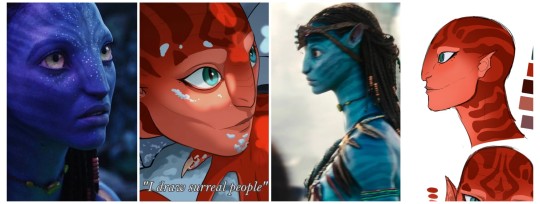
Later, it kinda became intentional because I want to make it look right, so I have been studying the structure of their skull to make it right. I also got a bit of inspirations from Venom for her metamorphosis and head shape:

I think that most of my creations might carry some inspiration from Avatar because the visuals are simply stunning and it's a way for me to simply pay homage to one of the films that shaped my imagination. Here are other examples too:
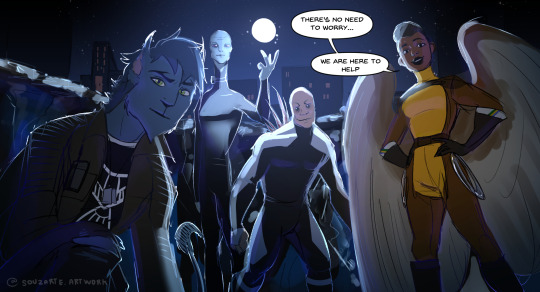


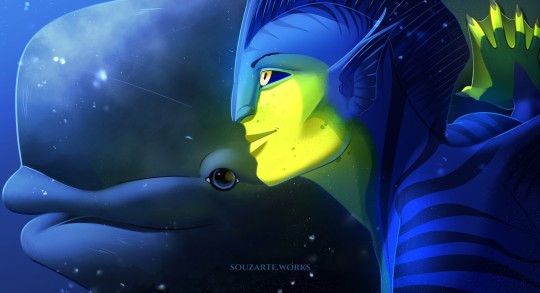


(...These are just a very few examples :') I wish I had more to show)
About the inspiration, what inspires me is the sence of wonder that the characters can have and what I want them to be. If I feel they need to be scary, I get inspired by the horror and the unknown. If I feel they are misterious and "beautiful", I get inspiration from birds, animals and the essence that I want them to portray.
But my biggest inspiration is this little sentence: What if...?
What if I create a person mixed with a manta-ray?
What if... I make a monster that isn't what it seems?
What if I mix birds and magic to create something new?
Explore the limits and possibilities of stories is what inspires me✨️ This little sense of wonder is what keeps me moving forward.
And there's one more crucial thing: I also dream a lot.
Like... lucid dreaming. Dreams with stories with part one, two and three, new characters and designs coming here and there, epic stories and tales that I feel the urge to write. I just naturally have this mini oniric universe inside my head and I have too much information, so I never run out of ideas! NEVER! (It makes me crazy sometimes, too much information)
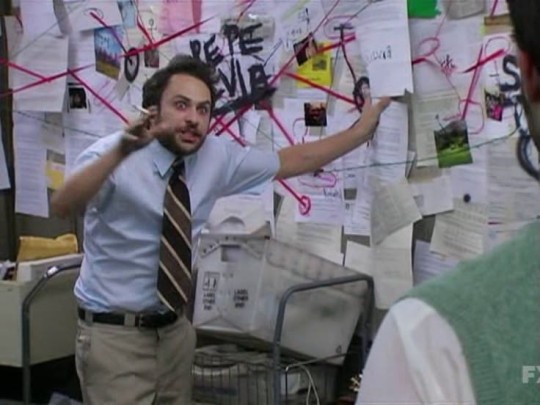
Really
I have wrote about eight dream journals untill now. This is what boosted my creativety, inspiration and even improved my memory. I can remember with details several scenes after waking up. And in many of them, I dreamed with my aliens. I dreamed Reeda I also dreamed the blue merman above. I dream them and I just know what to draw.

Well... I think I got a bit carried away and I wrote a gigantic thing, lol
My tip to be a better creatir is: be a dreammer and see the little wonders of the world, it can help a lot with your creativety ✨️
I hope that it was enought to answer your question :] Thank you for sending this ask!
4 notes
·
View notes
Text
Writerly Questionnaire!
Thanks for the tags @the-golden-comet and @saturnine-saturneight!
About You
When did you start writing?
Well I have a set of boxes in my room and each one contains a different story or world I daydreamed, planned out and wrote. Lots of them have bad early maps and actually some interesting concepts. The first box was from when I was around 7.
Are the genres/themes you enjoy reading different from the ones you write?
No, not really. Other than the physics and historical non-fiction books I enjoy, I read a lot of fantasy and write fantasy.
Is there an author (or just a fellow writer!) you want to emulate, or one to whom you’re often compared?
Hmm… I haven’t really been compared to anyone else as of yet. I am aiming for the convincing magical aspects of Brandon Sanderson with the wonder and worldbuilding of laini taylor and susannah Clarke. This is wildly ambitious at the moment, but I am willing to do lots of practice.
Can you tell me a little about your writing space(s)? (Room, coffee shop, desk, etc.)
I usually am the most productive on the notes app on my phone at like 8:10 in the morning before my classes at a desk somewhere. I then send that sessions writing to my laptop for me to review and adjust things.
What’s your most effective way to muster up some muse?
I daydream a lot. Although for practical writing stuff I like to find like 3-5 scenes in published books which are similar in tone or pacing to the scene I am trying to write and I look at their sentence structure, what type of description they use, what they focus on in the scene, etc. That helps me get a sense of where to start and I build from there.
Did the place(s) you grew up in influence the people and places you write about?
I guess. I grew up in England and wales, but my family travelled a lot when I was younger, for example we drove all the way to Italy from England once. I think that, and my extensive research, has given me some insight into multiple different cultures, however none of my stories have ever been set on earth, so this only loosely applies.
Are there any recurring themes in your writing, and if so, do they surprise you at all?
No… I would never do that… *looks at my one problematic but trying to improve character, then glances over to their mandatory emotional support*
*Avoids the gaze of the morally grey character sitting next to them.*
No but why does every story I write end up with at least two from this trio.
Your Characters
Would you please tell me about your current favorite character? (Current WIP, past WIP, never used, etc.)
Don’t make me choose! I love Apollo because he is an incredible person and my comfort character. I love marsh because he is so remorseless and fun to write, becuase his morals are so internally consistent and logical, yet completely contradict assumed morality. I love Xaeren because he is so witty and sarcastic, but also is deeply driven to do what he thinks is right.
Ok, but after all of this, my favourite character is going to have to be Olsaan. He is the god of death, and I love him because he is the idea of divinity so perfectly condensed. He is inevitable. His patience is eternal, he is as old as time and willing to wait until the sun explodes for you to pass, becuase in the end, it is the same outcome as if you had died today. All souls pass to him and he feels no need to rush them. Everyone will arrive home in the end.
It is so fun to write him at first as a caring human person, but then slowly revealing that he, however kind he is, he will never be close to mortal.
Which of your characters do you think you’d be friends with in real life?
Apollo. He is just so lovely. We could talk for hours about magic and do scientific research together. It would be incredibly fun.
Which of your characters would you dislike the most if you met them?
Probably the Avandil family. They are a runic family like the Ponturesi, but instead of doing the mix of mental manipulation and also just physically keeping them against their will and hurting the runics, they instead use only manipulation techniques and break children’s minds rather than their bodies. While runics can physically recover from the Ponturesi, almost all of the Avandil kids can never exist in society again without the command of the Avandil, because their minds are so fractured.
Tell me about the process of coming up with of one, all, or any of your characters.
Ok. I made up Paeliae because I had written so much history about the dissolution, and I needed someone to show it. I made him a politician and interested in immortality and sayleren so he would be closely involved in that plotline when the gods attack sayleren. Then the rest of his personality developed in interactions I imagined with other people who would exist at the time.
Character creation for me tends to start with either a particular event or concept I want them to show, or a particularly vivid daydream, then I give them other people to show different facets of their personality, then I give them flaws and morals. That’s it.
Do you notice any recurring themes/traits among your characters?
Yeah, the clever sarcastic main. It comes up along because I enjoy writing it, but I am always careful to diversify them by giving them entirely contradictory morals and justifications. They have different lines that they won’t cross and different life experiences, just an overlap in tone sometimes.
How do you picture them? (As real people you imagined, as models/actors who exist in real life, as imaginary artwork, as artwork you made or commissioned, anime style, etc.)
Depends. They are all in the same world so they should probably all be one style, but I imagine the Apollo and Tyro WIP as real people, but the marsh and Paeliae WIPs as good quality realistic animations.
Your Writing
What’s your reason for writing?
To get some of these ideas out of my head. It’s getting a little full in there and they just need to go somewhere. I suppose the technical term would be creative outlet.
Is there a specific comment or type of comment you find particularly motivating coming from your readers?
Anything about good action or descriptions is always motivating, because I consider those to be my weakest areas. Don’t get me wrong, I also really appreciate anything about dialogue and worldbuilding, but the others are particularly motivating because it means that I am improving.
How do you want to be thought of by those who read your work? (For example: as a literary genius, or as a writer who “gets” the human condition; as a talented worldbuilder, as a role model, etc.)
I want people to like my worldbuilding. There is a whole lot of it. I also think I build quite interesting characters and dynamics. I don’t really want to be thought of as one type of author. Just a hobby writer who is learning and will get there one day.
What do you feel is your greatest strength as a writer?
Worldbuilding and Dialogue.
What have you been frequently told your greatest writing strength is by others?
Dialogue.
How do you feel about your own writing? (Answer in whatever way you interpret this question.)
Hmm. I don’t like it. I don’t like reading my own work back, it always feels so awkward. I can appreciate when I get a good line or a nice flow in a particular scene, but those moments always feel rare.
If you were the last person on earth and knew your writing would never be read by another human, would you still write?
Yes. I wrote for years before I showed it to anyone. While I love sharing my work and getting input, I write mainly for myself, and not to popularise it. I would miss all of you though <3
When you write, are you influenced by what others might enjoy reading, or do you write purely what you enjoy? If it’s a mix of the two, which holds the most influence
Both. I feel like the writing I consider good quality is something that I, and others can enjoy reading, and this is often hard and not fun to write but i do it anyway because I comes out better.
On the other hand, the themes I put into my stories are always things that interest me, for example the concept of immortality and the implications of that on a society, or the logical moral justification for mass murder. So themes that I enjoy, but the structure and actual writing is written for enjoyment while reading.
Tagging @drchenquill, @theink-stainedfolk, @honeybewrites, @tildeathiwillwrite, @kaylinalexanderbooks
@winvyre, @willtheweaver, @the-letterbox-archives, @somethingclevermahogony and @illarian-rambling
18 notes
·
View notes
Text
media roundup february
hi everybody :3 i didnt really read a lot in february i was busy 'doing school' and 'looking for employment.' sad! i have spring break coming up so im planning on using that time to read a bunch (and also apply for more jobs -_-) this post and previous can be found on my neocities!
books:
revenant gun by yoon ha lee: the last book in the hexarchate series, starting with ninefox gambit. (slightly edited from my discord review, SPOILERS INCOMING). in machineries of empire, there a disconnect between what the audience craves and what the book is willing to give them-- for example, things like Whats up with the calendar + the hexarchate, why did jedao do all that, etc. this works in the books favor (imo) by increasing tension, creating a sense of discovery, and avoiding clunky exposition.
however in the two sequels it expands not just to what the audience wants but also what they like. care about? some big examples are the weight of the remembrances* and less cheris, but also stuff like jedaos focus. which isnt bad like i like jedao. but like, if you Dont you sure do get a lot of him. also did anyone actually like brezan sorry. hes fine like for example with the end of a memory called empire, when the protag (forgot her name sorry) loses her brain buddy, it feels like a second coming of age almost--her brain buddys been a crutch but now she gets to stand on her own (albeit as a changed person, with brain buddys influence). vs cheris who kinda starts to feel like a cameo character who literally fucks off for nine years??? there is also a sort of ongoing sense of "these sacrifices for the greater good are ok (if sad) and these are not" whihc ngl sometimes feels pretty arbitrary to me. and given that machineries of empire focuses on like the Littlest most downtrodden people it really is wild yhat we dont see a lot of civilian life? anyways i enjoyed it and i think its worth finishing out the trilogy but it wasnt as satisfying as i could have hoped (ALSO NINEFOX GAMBIT IS A REALLY FUN SOLID READ. I LIKED IT A LOT)
*the rememberances are a set of ritualized tortures that create a power structure that literally powers a lot of the empire's technology. this is a very cool concept! a big part of jedao and cheris' rebellion is about making a place that Doesnt have to run on torture. except that like, besides the intellectual knowledge that Torture Is Bad as a reader i didnt really feel that invested in this? like we only get to See a remembrance happening midway thru book 3. im not like advocating for torture porn or anything but it seems weird to have that be the focal thing when neither cheris nor jedao had any scenes where they were affected by it (and so the audience didnt have anything like that either). idk it kinda just stood out to me. like yes i care about these characters but why should i care about This specifically
hexarchate stories by yoon ha lee: an anthology set in the world of machineries of empire, expanding the world and fleshing out some stories. this was pretty solid! theres a wide range of stories and lengths, and i liked the variety :3 its like a little charcuterie board. (yoon ha lee's bias for shuos jedao really stands out here though..) its kinda essential reading to me imo though bc otherwise the ending of revenant gun isnt that satisfying :| lol anyways once again if youve read ninefox gambit check it out! spoilers for the whole series tho
exordia by seth dickinson: hard scifi about agency, impossible choices, and how they shape you. also, international geopolitics! like ninefox gambit, exordia demands your attention and concentration. you kinda have to read it at a time when you have brainpower to spare. however, exordia rewards everything that you put into it :3 i ended up learning so many random facts during this book… like AGL meaning above ground level. i feel like i need to read a book about democratic confederalism now also. a couple of my other friends read this book and got lost in the large cast and intricate web of events--i didnt have as much of an issue but u might need a piece of paper or sth. exordia is a book that's dense enough to feel like three books, and that can be good or bad. seth dickinson has this really spare, concise prose that leaves a lot to your imagination but also like. can sum up a person or situation in just a couple sentences? and that leaves a lot of room for the reader to investigate which i like :3 hm what else to say…. i really liked clayton (clayton!!!!) but i found erik super annoying ymmv. the ending kinda leaves you at a loss which i honestly kinda like? like yeah obv a sequel would be nice but i like it the way it is. anyways not for the faint of heart but id still recommend<3
accidentally engaged by farah heron: f/m romance aww so cute <3 really nice contemporary romance which tosses together a bunch of tropes--arranged romance, fake dating, baking together--into something that actually works really well! the two leads were very charming and i liked reading about the good food. i liked the way the protagonist's almost-stereotypical portrait of a loving but strict south asian family (am i allowed to say this) gets fleshed into a group of honestly kinda bizarre people that love her and that reena can genuinely connect with. yay family! overall, not especially memorable to me personally but still enjoyable. rec if youre into contemporary romance
last breath: the limits of adventure: realistic fiction (?) about what it feels like to drown, die of dehydration, fall from a cliff, etc. lots of research, very thorough! (well sometimes they live and sometimes they dont). an expansion of this absolutely fantastic article about hypothermia. honestly none of the stories quite live up to this one imo but this is still a really solid and exciting read! i couldnt put it down! although it does have a touch of the orientalism that you get from like, a lot of extreme sports circles lol. i would definitely recommend reading the article, and maybe read the book if it especially interests you.
video games:
pokemon legends of arceus: a pokemon game set in the past that breaks the mold by letting you dodge roll. my opinions here coincide pretty closely with the dunkey video, which is that this is a really fun game that is also literally half finished. controls are clunky, story is paper thin, graphics are fucked, overworld is extremely empty but its also just very fun?? it took over my life for like two weeks and i missed class???? anyways i would not get this at full price but if you can borrow it from a friend its super interesting to experience. im looking forward to the kalos one :3
slay the princess: a horror? romance? visual novel about saving the princess, slaying tbe princess, and everything in between featuring the vocal chops of that one magnus archives guy. dudeee this is so fun! i think its very kind to the guy inside of me who is Embarrassingly Anxious about any and all video game choices that can like, affect the narrative. lmfao its fun to fit in a couple runs or two between other things, but i did start losing track of what previous paths id taken after a bit of a gap. however!!! i would definitely think about playing this game if you like visual novels or Narrative or Loops! or girls who kill lol theres a free demo if you want to try it out
movies:
velocipastor: action movie about a priest who turns into a velociraptor to punish the wicked!!!! so fucking cool a lot of love put into this (low budget) movie made me so sad i dont speak cantonese (? at least i think thats what it was) watch this with friends
music:
Gato by nobonoko: really fun 80s synth jazz? album written by two fictional gay furries. no wait come back ok this is one of those things i got recommended by youtube and then actually listened to it a bunch of times its just very soothing and nice :3 ive been listening to jazz pretty much my whole life so i have a huge bias. also im a sucker for fictional bands eg splatoon… also the art is so cute?? those two guys?? its hard to pick a favorite song but i think i like the titular gato! also theres a bunch of other stuff made by the same two artists
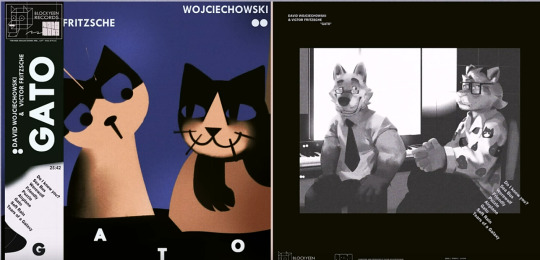
option by Crosses: i totally forgot what the genre for this is but its like when metal guys are like i need to have a song for my metal wedding. song recommended by neil -_- anyways very sappy im fond of it nonetheless. i definitely did think it said "can you promise me to the grave"
Roy by Idles: from british rock band idles new album tangk! im going to be honest i did not like this album as much as some of the other ones by idles, but thats ok! hmm when i play this song out loud during crew shifts i feel embarrassed. but i really like seeing how idles' vocalist's voice has evolved over time! the way hes branched out into more melodic and belty stuff over time is very fun. the prechorus + chorus are very fun to sing along to as well :3 its just a fun song
anyways if you read any portion of this thanks as always :3 what else to say.. i made pandesal recently and its been my only successful bread that i can remember. go me! anyways see you guys in a bit
9 notes
·
View notes
Text
a brief-ish breakdown of くれる and もらう!
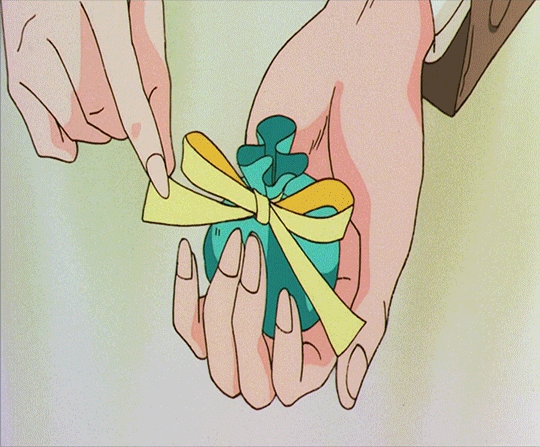
hi all! it’s been a minute since i last wrote a grammar post, but this particular topic has been popping up a lot for me lately so i thought i’d write my own explanation. the difference between these two used to confuse me a lot (and, let’s be real, sometimes もらう is still so confusing lol), but i think it can actually be explained fairly simply. so let’s get to it!!
types of differences between words: grammar vs. semantics
“wait, wait, what??” i hear you say. yes, it’s true—as a linguist i am incapable of explaining a grammar item without also explaining a little bit about human grammar itself. whoops 😉
so, as i’ve implied in the title, words can differ in multiple ways; for くれる and もらう, we’re interested in their grammatical (or “syntactic”) difference as well as their semantic difference. grammar, as i’m sure you know, refers to the structure of language, including word order, word movement, and stuff like that. in this case (くれる/もらう), we’re going to be mainly concerned with particles, an integral part of japanese syntax. so keep that in mind.
semantics, on the other hand, is something you might not be as familiar with (or at least not outside the phrase “just semantics”). semantics basically refers to the meaning of a word or phrase, notably without social context. to give an american english example, the words “you guys” and “y’all” are semantically identical because they both denote the exact same thing: a group of multiple people whom the speaker is addressing. however, any native english speaker can tell you that people do not really use “you guys” and “y’all” interchangeably, largely for social reasons (e.g., where you’re from, your gender identity, etc.).
so, to summarize: grammatical differences are differences in structure, while semantic differences are differences in meaning (without social context). now let’s move on to くれる and もらう!
くれる grammar basics
you might know already that くれる is the japanese “giving” verb. more specifically, it’s the giving verb whose subject isn’t the speaker:
❌ 私が弟にプレゼントをくれた。*
⭕️ 兄が私にプレゼントをくれた。 = my older brother gave me a present.
from these examples, we can deduce two facts about the grammar of くれる:
the giver is marked with が, meaning the giver is the subject.
the recipient is marked with に, meaning the recipient is the indirect object.
these rules apply to くれる used as a solo verb and as an auxiliary (as in 〜てくれる). this grammatical construction is pretty familiar to english speakers, who can say things like “my brother gave a present to me,” mirroring the 兄が私に structure in japanese. english-speakers also might feel like the giver has a more “active” role in the scene, which lends itself well to the giver being the subject.
*in this case, if you were going to use a giving/receiving verb, you would use あげる.
もらう grammar basics
in japanese, もらう is the “receiving” verb, and in fact the only* receiving verb: there is no out-group/in-group distinction here like there is with くれる. let’s look at some examples:
❓ 私に弟がプレゼントをもらった。 = ?my little brother got a present from me.
⭕️ 私が兄にプレゼントをもらった。 = i got a present from my older brother.
the first example, marked with ❓, is not technically grammatically incorrect (as far as i know), but it is sort of awkward, just like in english. the second example, on the other hand, shows us exactly what we need to know about the grammar of もらう:
the giver is marked with に**, meaning the giver belongs to a prepositional phrase.
the recipient is marked with が, meaning the recipient is the subject.
are you seeing an important difference between もらう and くれる? you probably noticed: while the subject of a くれる phrase is the giver, the subject of a もらう phrase is the recipient. this makes it really obvious that くれる is about someone giving something to someone else, while もらう is about someone receiving something from someone else.
as with くれる, the above rules apply to もらう as a solo verb and the 〜てもらう auxiliary construction.
*in this post, i’m ignoring 敬語, so technically there are indeed other receiving verbs (like いただく), but only as far as formalities go.
**the giver in a もらう sentence can technically also be marked with から, but i don’t feel like that’s very common to see.
the semantics of くれる and もらう
let’s compare the two correct examples from the above sections:
兄が私にプレゼントをくれた。 = my older brother gave me a present.
私が兄にプレゼントをもらった。 = i got a present from my older brother.
now, imagine a scene on a stage where no words are spoken: someone labeled 兄 mutely hands a wrapped gift box to another person labeled 私, and then the curtain falls. how would you describe that scene you just saw—using the first sentence, with くれる? or using the second sentence, with もらう?
if your answer was “i don’t know,” or maybe “what’s the difference,” then you’ve actually hit upon something really important about くれる and もらう! while certain social implications might be different between the two verbs (e.g., was 私 expecting to get a present?), the semantics of くれる and もらう in this construction are functionally identical. remember, semantics ignores social context, so whatever the particular circumstances of this gift-giving scene, the fact remains that a present changes hands from 兄 to 私, which can be accurately described by either the first example sentence or the second. to put it simply, the constructions XがYにZをくれる and XにYがZをもらう mean the same thing! it’s easy to remember that way, right?
summary!
so, we’ve looked at the grammatical differences and the semantics differences (or lack thereof) between くれる and もらう. here they are:
in くれる sentences, the subject (marked with が) is the giver. in もらう sentences, the subject (marked with が) is the recipient.
in くれる sentences, に marks the recipient. in もらう sentences, に marks the giver. this means that the grammatical (particle) structure of くれる and もらう sentences is reversed.
the constructions XがYにZをくれる and XにYがZをもらう are semantically identical, i.e., they mean the same thing. this is true of sentences where くれる and もらう stand alone and sentences where they are auxiliaries following the 〜て form of another verb.
and that’s that! obviously there are always exceptions and complications to rules, but i hope that my explanation of these two words has been helpful for you. i spent a long time not understanding how to use もらう since it didn’t really feel like anything we had in english, but once i learned exactly how it was related to くれる, i think started to get the hang of it—and i bet you can too!
as a final note: if people are interested in more posts about もらう (which i have personally found is the trickiest for english speakers), i might have a post about semantic-passive もらう coming down the pipeline, so keep your eyes peeled! またね!!
47 notes
·
View notes
Text
it constantly boggles me how fans of a show about logical reasoning and deduction often fail to apply those skills to their analysis of the show
(yes this is a deduction post, I do have some ~advice~ at the end)
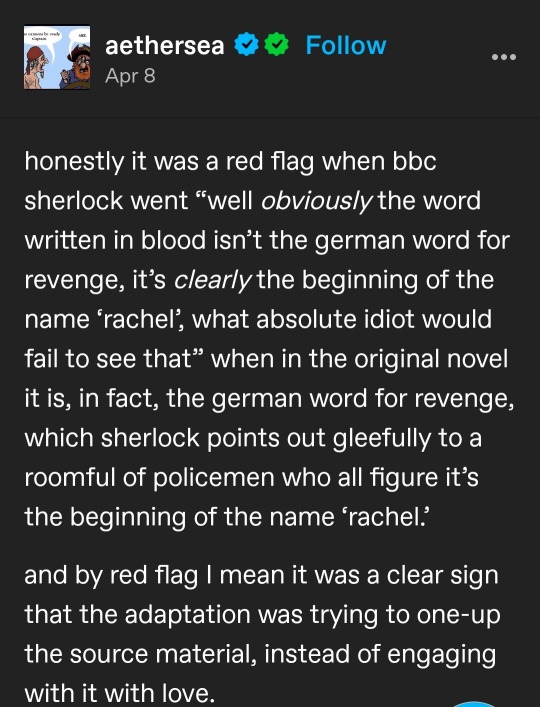
~
Anderson is the one who mentions "rache."

Anderson is a dick to Sherlock, and Sherlock dislikes him - this is the First Episode and those sorts of character relationships need to be established.
Sherlock does not actually think that "obviously the word in blood is not German for revenge, it's the name rachel" - since he literally considers the German possibility first:
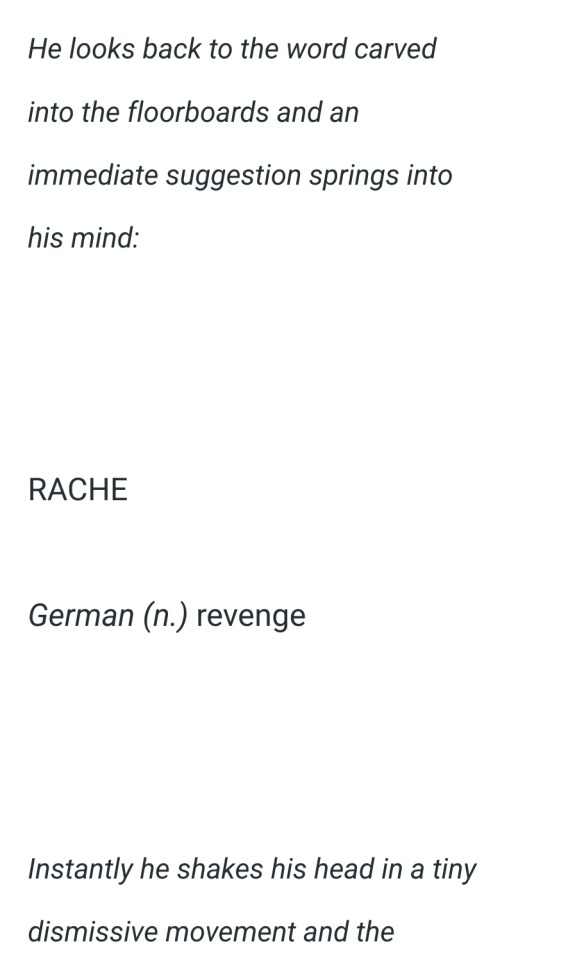
The "obviously" is what Sherlock outwardly portrays to others, specifically Anderson - the scene is of course a nod to the original (while switching it up a bit because that's what adaptations are meant to do) but the scene is also part of a larger plot/episode, and it helps establish the sort of relationship Sherlock and Anderson have. His dismissal of the idea is intentional and who he is dismissing is also intentional for purposes beyond being a nod to the original.
So like, someone might be able to come to the conclusion "bbc sherlock was focused on one upping and not showing love to the original" but not using this scene as an example.
~
If you look at OP's thoughts as a sort of "deduction" about the show/the intents of the writers, we can note a few deduction lessons here:
1. Don't look at something in a vacumn; think about the wider context surrounding something.
Immediate context: Who is Sherlock speaking to? What is going on inside Sherlock's head surrounding his actual dialogue? (since in this show we often have access to that! use everything you have access to with deductions)
How to apply to real life deduction: look at where someone is, who someone is talking to, etc.
You can go further too - the wider context here is this is a TV show: a specific structure that needs to be followed - characters need to be established, conflict needs to happen, etc. (thus it making sense to conclude that Sherlock was written to react that way to Anderson specifically in order to establish that character relationship)
How to apply to real life deduction: the wider context would be like, what country/city is the person in, what is their culture, what is their life like beyond the instance you're observing?
2. Don't jump to conclusions (or jump to throw evidence at a conclusion). Tread carefully!
Sometimes, you might have a potential deduction, based on a few pieces of evidence, but not quite enough information to be sure. So, you look for other evidence (observations, etc.) that could support that deduction.
I don't recommend making that a habit, but if you're doing that, make sure you review the evidence carefully before using it to support your deduction!
Because here, if OP had considered the context of the scene more, OP would have realized that the scene does not support the conclusion.
~
#like there are definitely elements of bbc sherlock that are mainly about one upping the original#but this aint it#tho like#one upping and showing love arent mutually exclusive#and adaptations should be trying to do both#deduction#sherlock holmes#sleuth2k7#deductionist#deduce#learning deduction
16 notes
·
View notes
Text

I finally got around to watching Baz Luhrmann’s Elvis (2022)... i procrastinated for so long just because I’m not a biopic person but I watched enough video essays on YouTube and decided to give it a chance.
I think it’s hit or miss.
The editing of course is phenomenal and so is the cinematography. But the fast-paced editing gets tiring after 30 minutes and it’s basically an almost 3 hour music video montage. I can understand if they did this style for the film’s opening or had some musical breaks in the middle of the story structure to keep things moving, but no basically the entire movie is like this one big montage. It should have been used sparingly but Luhrmann does nothing in moderation.
I’ve never been a big fan of his movies tbh... his style is unique, I’ll say that much but I honestly hated Moulin Rogue! and his take on Romeo + Juliet simply because I couldn’t get invested in his characters. Like most of Luhrmann’s films, it is pretty much style over substance. I watched one video essay which stated that at the end of the movie we still don’t really know who Elvis was and I kind of agree. Because the editing is so choppy and moves us quickly through Elvis’s life almost like a roller coaster at a carnival we never get a sense of who the characters are. We never stay with them long enough to develop an emotional connection to anything happening on screen. There’s a total disconnect because it’s just pretty to look at. Great visuals but no real meaning behind them. There’s really no linear storyline. We witness Elvis’s life through fragmented pieces.
For example, there’s a scene where his mother collapses on the stairs and dies and we get a quick 5 second dissolve to her lying in an open casket which fades to another 5 second dissolve to Elvis mourning his mother before we jump quickly to the next scene. This scene moves so fast that we can’t even digest what we’re seeing or be able to understand how the loss of his mother devastated him because it’s just a montage and not an actual scene. So I can’t say the screenplay has really great writing. The film seemed to be more focused on making a beautiful looking work of cinema and it is. It’s beautiful on the surface but movies don’t mean anything if you can’t feel an emotional attachment.
As for the positives:
I do like the idea of telling the story through Col. Tom Parker’s perspective. That was pretty creative. You almost get a Jesus Christ Superstar treatment, seeing Elvis as some mythical figure. They expertly hide his identity at the beginning of the film because it is being told through Col. Tom Parker’s POV. In this way we get an unreliable narrator. Elvis’s introduction is well done.
I love that Austin Butler does his own singing. He really does embody elvis and the casting here was on point. The soundtrack is great.
I do like the film having a more fantasy/ musical approach as opposed to being a straight up biopic. But I feel like if we took the editing of this movie and applied it to something with more of a coherent narrative it would have been a really good film.
I give it a C+ for effort. They recreated some historical moments really well. The costume/ hair/ make up department outdid themselves, not just on Elvis’s wardrobe but the extras looked great, too. Also nice to see some well-played cameos of B.B. King, Sister Rosetta Tharpe and Little Richard.
Stunning visuals overall but really lackluster screenplay that needed more work to make me care about the story and characters.
It was like watching a 2 hour and 40 minute music video with very minimal story.
I give it a 7.5/ 10 stars.
15 notes
·
View notes
Text
How to Test your Story
While writing, you may be wondering how to check your story for any random errors or mistakes properly. Here's a great guide that'll show you how I check mine!
Check the spelling and grammar. Typically, I don't have many grammar and spelling issues since I'm a native speaker, but that doesn't mean I shouldn't check for typos since they are common. Not only that but awkward phrases and incorrect wording happen to everyone. Because of this, it always pays to double-check to ensure your writing is quality.
Check the directing through the web previewer, scene by scene. Typically, after I write dialogue and direct a scene I usually check the scene in its entirety when it's done, but once again it pays to double-check. Here I look for flow. This can be through dialogue and making sure that the characters are not stagnant. I also try to make sure the dialogue makes sense by reading it out loud or whispering it to myself.
Check the directing in the Episode app. Some coding commands like typable choices don't show up in the web previewer, making it important to check in the app. You won't know if everything is to your standards until you check the app!
Check the chapter plans with the chapter. Here I make sure my writing matches up with the plan I originally set. This is helpful to make sure I stay on task with my writing. It can help foster clear writing, and good structure and can contribute to an overarching theme.
Make sure my goals are achieved. For chapters that need more structure, I try to write notes for an end goal. An example of an end goal might be "I want character A to get to know character B", so it can be helpful to double-check that this happens throughout the chapter.
Make sure the chapter is interactive. I prefer to make my stories more interactive, so to ensure this I try offering clothing choices, makeup choices, customization, tappable overlays, choices, timed choices, and more! Of course, this is all optional, but if you like interactive stories I suggest you try to make sure your chapters have this.
Time the chapter. Sometimes, I can tell if a chapter is going to be over my usual time or under just by looking at how long it takes me to write it, but I always try to double-check. I take out my stopwatch and read everything I write out loud, almost as if I'm reading the chapter for the first time! However long you make your stories, make sure you try and stay consistent. That way, your reader always knows what to expect.
And finally, I try to do one last play-through to make s everything is fine. Once all the corrections I can think of are made, I play the chapter one last time before getting ready to publish. This should be as relaxing as possible, and if anything goes wrong, I repeat the steps and apply corrections.
1 note
·
View note
Text
What makes movie action “good?”
There’s a John Wick movie in theaters. There seems to be pretty uniform agreement that John Wick movies have great action, and simultaneously, there seems to be a lot of general “Marvel fatigue,” some of which is specifically about the MCU, but also some of which is about “action blockbusters” that seem to put a lot of focus on action and spectacle that a lot of people seem to be growing increasingly disenchanted with. (See, for example: Tomorrow War (2021) starring Chris Pratt, Extraction (2020) starring Chris Hemsworth, and to round out the Chris roster we also have Wonder Woman 1984 (2020) with Chris Pine.)
Most of the discussion tends to focus on effects, and how making everything in a computer feels soulless while practical effects like the ones in John Wick and Everything Everywhere All At Once are superior, and there’s a certain degree to which blockbuster CG does look worse due to everything being computer generated. But I think a much bigger and more deep-seated problem is that blockbuster action is poorly structured.
There are a lot of great practical scenes in John Wick with choreography that is great not just in execution, but in concept: if you recreated them with computer animation, or hand-drawn animation, many of them would be just as fun. You could look at a storyboard with a director’s poorly-drawn pencil sketches and you’d still be able to follow the logic and understand what the scene’s impact is supposed to be. You can tell this, because people can describe these scenes, and regularly do exactly that, because they’re memorable. It’s what the legend of John Wick is all about. (And it’s not just the “top 10 most creative John Wick kills” listicles that remind us of that fact.)

The thing is, John Wick doesn’t rely on the unique outlandish props for memorable kills. Most of John Wick’s kills boil down to “point gun, pull trigger.” And yet despite that most of his kills are with bullets, so many of them feel unique. Each scene feels like it has a tempo to it, a sense of flow, a chain of cause and effect. “That guy is hiding behind a pillar, but his toe is sticking out. So I’ll shoot him in the toe, causing him to bend over in pain, exposing the rest of his body so I can shoot center of mass.” There’s always the moment when John Wick runs empty and has to reload before delivering the killshot.
There’s a storytelling principle that’s often applied to plot structure. This was famously described by Trey Parker to a bunch of NYU students on MTVU's "Stand In." Trey Parker describes the writers room as containing a massive white board, split into 3 acts, where they write down ideas scenes and rearrange them. Each scene has to be entertaining by itself, but they also need to be connected by a coherent narrative through-line.
"You don't want just one scene where, 'well, what was the point of that?' Take the beats of your outline, and if the words 'and then' belong between those beats, you've got something pretty boring. What should happen between every beat that you've written down is either the word 'therefore,' or 'but.'”
A happens, therefore B happens. Or, B doesn't happen, but C happens, therefore D happens. Repeat. You can use this to structure the plot for a 25-minute TV episode, or a 120-minute movie, or a 2-minute action scene. Follow it, beat by beat, and see if one leads to the next:
One of the evil henchmen comes swinging at our hero with a wooden chair raised over his head, but the hero dodges and the wooden chair smashes against the floor, shattering. Therefore, the ground is now covered with the broken remains of a wooden chair, so the mook picks up one of the long pieces of wood that served as a chair leg and begins swinging at the hero again. But the hero successfully dodges and the wooden club breaks and splinters in a way that causes it to become, therefore the mook starts trying to use the splintered end to stab the hero...
I’m not saying this is an amazing action scene, but it’s a competent one: each beat flows into the next. The chair becomes a chair leg, then the chair leg becomes a shiv. Each time the henchman comes rushing at the hero, he’s doing it with a different weapon. The scene has a logic to it: if you rearranged the shots, the scene wouldn’t make sense. You can’t start with a splintered piece of wood and then end on an intact chair.
So many mediocre action movies fail to deliver it. The bad guy punches the hero. And then he punches the hero again. And then he tries to kick the hero. And then he punches in a different, cooler way. There’s no real sense in which each beat is a consequence of what followed it: if you cut the scene up and rearranged the shots, a lot of people might not even notice. (And in fact that sort of thing happens all the time in the editing bay.)
Tony Zhou self-deprecatingly describes this problem when critiquing one of his own videos, saying “This is a list you could put in any order. That’s why it’s so boring.”
For examples of action cinema where every beat feels like a consequence of what preceded it, watch any classic Jackie Chan movie (the ones that came out of Hong Kong, not Hollywood). Tony Zhou describes it like this:
“So how does Jackie create action that is also funny? First off, he gives himself a disadvantage. No matter what film, Jackie always starts beneath his opponents. He has no shoes. He’s handcuffed. He has a bomb in his mouth.“

“From this point, he has to fight his way back to the top. Each action creates a logical reaction. And by following the logic, we get a joke.” (Jackie is facing an assailant with a gun; Jackie has a gun, but it’s empty. Therefore, Jackie fakes surrender, handing his empty gun to the assailant. Therefore, the assailant is now holding an unloaded gun in his left hand. The assailant now thinks he has control of the situation, but reaching for the unloaded gun distracted him the fact that Jackie was entering a fighting stance and getting ready to kick: therefore, when Jackie kicks, he succeeds in knocking the loaded gun out of the assailant’s right hand. Therefore, the assailant tries to fire at Jackie using the gun in his left hand -- which is empty, and he realizes it in a moment of surprise which Jackie seizes on by punching the assailant in the face.)
This is the joy of watching Jackie Chan films: much like the example of a chair (which morphs into a chair leg, which morphs into a shiv), a prop in a Jackie Chan movie is rarely just one thing. A ladder isn’t just a ladder; it’s a prop. And it’s several different kinds of props. Fighting with a ladder like this:

...is subtly different than fighting with a ladder after this happens:
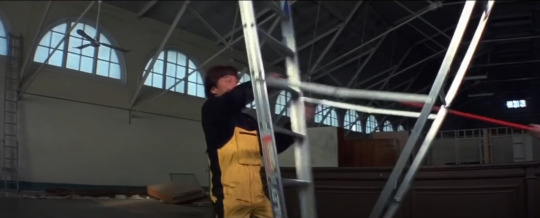
And if you flip it over a guy’s head, it suddenly becomes a cage:

...trapping a guy just long enough for him to look at you in surprise right before your fist intersects with his face.
It’s great for action comedy, but it’s also great for straight action: sometimes, the “punchline” is someone getting defeated in a surprising way. John Wick is one of the few big franchises of recent years to reliably do this sort of thing well.
Often, John Wick accomplishes this by being clever. But I think a big part of it comes down to the fact that John Wick is just mortal enough for the number of bad guy’s he’s facing to matter. Each scene needs a sense of “progress,” where the stakes are constantly changing, and sometimes the change in stakes is as simple as, “There are five bad guys, oh no!” Bang bang, pivot, bang bang. “Okay, now there are only three bad guys.” (It’s harder to do this when you’ve been injected with super soldier serum and wear a suit made of high-tech blast resistant stretch fabric: Captain America subduing five bad guys doesn’t feel meaningfully different from him subduing three bad guys, even if the way he punches them is really cool.)
Stakes matter! If threat level scales linearly with the number of bad guys on screen, then each scene will have a natural eb and flow to it as bad guys get gradually picked off (or as more of them stream into the room, or pick themselves up off the floor and reach for the gun they just dropped).
One of the MCU scenes that actually did this better than most is the famous Captain America elevator scene: first, Crossbones and two guys get onto the elevator with cap. A bit surprising. Why is that guy resting his hand on his hip so close to his gun? Several floors later, the elevator opens, and four more guys get on. They’re wearing suits, like you’d expect from people who just showed up for a day at the office. This is headquarters, there’s nothing to be worried about. So why is that guy sweating? Then, the door opens again, and three more guys get on -- and these guys are wearing tac gear. But hey, it’s Jack -- I know Jack, he was in the first ensemble movie, he can’t be one of the bad guys...so why is he standing directly between me and the door?
It’s a great example of slowly amping up the tension by gradually adjusting the threat level up. The scene even amps up the tension by having the magnetic handcuff, which leaves Cap in various stages of incapacitation throughout the fight. And he has to fight his way up from the bottom. But we very quickly go from this iconic shot:
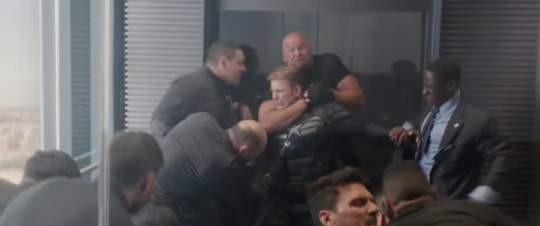
...then after literally three seconds of Cap delivering a rapid series of strikes to incapacitate most of the mooks, he’s back to fighting two or three of them at a time.
Despite there being ten bad guys in the elevator, it’s kind of hard to get a clear fix on how many of them attacking Cap at any given moment, all of the others existing in various states of injury and recovery after they get the wind knocked out of them. In fact, the only shot that allows us to get a full body count is after the fight is over:
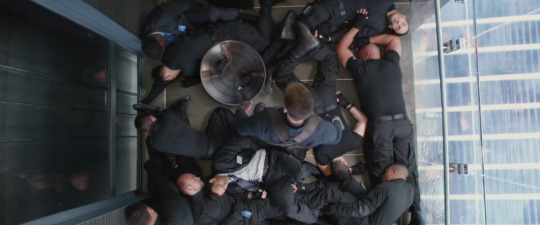
But it’s still a fun scene, one of my favorites, succeeding at being fun and memorable.
The bigger issue is the need to be “epic”: threat level can’t scale linearly with the number of bad guys on screen when you want a scene where there are literally hundreds of enemies to fight off.
There’s a certain point at which the marginal effect of another bad guy on screen is effectively zero. Obviously, this is the case when you have hundreds or dozens of enemies on screen, but there’s a real sense in which “group of seven bad guys” doesn’t feel different from “group of six bad guys.” Our brains just categorize both as “a pretty big cluster.” Research tends to come to slightly different results on this, but it seems like humans count “one, two, three, four, many.” Once you have five bad guys on screen, adding a sixth bad guy doesn’t do anything to change the stakes. (That’s the problem with having a hero who’s so strong that you need to throw 10 bad guys at him to pose any threat.)
If you cap the total number of on-screen bad guys at five, then each enemy the hero defeats meaningfully changes the stakes, and John Wick does this a lot. In many cases, the flow just comes from watching the number of bad guys on screen decrease linearly as the hero picks them off, one by one. It gives the scene a natural scenes of progress, and it can sometimes be played for comedy, like Neal Stephenson does in Snow Crash in a scene described by a sniper’s dialog:
"It's, like, one of them drug dealer boats," Vic says, looking through his magic sight. "Five guys on it. Headed our way." He fires another round. "Correction. Four guys on it." Boom. "Correction, they're not headed our way anymore." Boom. A fireball erupts from the ocean two hundred feet away. "Correction. No boat."
That’s a (very short) scene with flow. You can’t rearrange the beats; every beat leads to the next. Follow the logic, and arrive at the punchline.
252 notes
·
View notes
Note
How do you come up with your poses? They all seem so cool and I struggle with coming up with anything/finding references.
Posing huh? This is quite an interesting topic so let's have a real talk about it. Though it won't obviously cover every single details there could be and explanations may be sloppy, I am no real art teacher after all. By the way I apologize in advance if there is any messy spelling or grammar mistake as english is not my first language.
To begin with, let's say the key words here are force lines, simplicity and body langage. Anatomy is a whole another topic so I won't talk too much about muscles and bones, as we are mainly here for posing.
Firstly, what are force lines? To put it simply, a force line is the core line guiding the figure's movement but also the whole composition, thus also guiding the eye itself toward (or away) the most important parts. With shipping, Soukoku in particular (since they have different temperaments), I like to have two lines that complement each other, via either inner or outer curves.
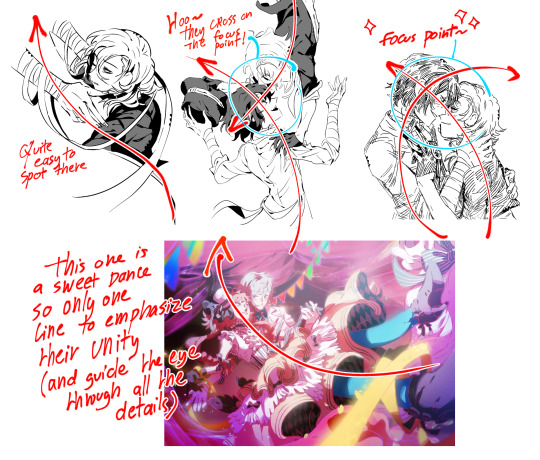
But those are whole compositions and we're not in a composition class either. However, when it comes to a single pose, the same principle can be applied. This force line can guide your whole body and even become your literal spine. As the spine is the most essential part of the human body (and non-human living body), it will act as the central part which the rest will follow naturally. Don't be shy and use a stickman for your overall structure! If you have a hard time simplifying the overall movement of your figure, try drawing it in a smaller size first. It doesn't matter if it looks ugly, you'll clean it up later.

If you're still struggling with your understanding of structures, try to decompose a reference picture (go check Pinterest, it's a true gold mine) with simple lines to determine where and how are positioned the spine, ribcages and main bones then transpose it to your own drawing as a guide.
"But how do I get those dynamic lines and cool curves??", you may ask. Well, have you tried figure drawing and more specifically gesture drawing? You can of course take a class with a nude model (they don't bite don't worry and you will focus more on the art part than the nude one), but you can also do so with tons of videos, pictures and even websites such as Line of Action, which allows you to have a custom built-in timer when drawing. To have only a mere 30 seconds to draw may sound terrifying but trust me, it's not that difficult. The point of drawing a whole figure in 30 seconds (or more) is to force yourself to simplify and avoid to focus on unimportant parts that aren't essential to the overall understanding of the pose. This will put you in a focused state of mind as well as training your hand muscles (this is a great warmup exercise). Feeling a bit uncomfortable on your wrist or feeling like you can only do tiny strokes one at a time instead of big elegant lines? Well firstly... stretch your wrist regularly, drink water and stop drawing every once in a while, this is very important, may you be a beginner or a professionnal artist. Secondly, try drawing on a bigger format! It will train you to use your elbow and shoulders to draw big lines more easily, like getting a bigger compass to draw a circle. I for example draw mostly with my elbow and shoulders, even unconsciously, as this is way more comfortable for me.
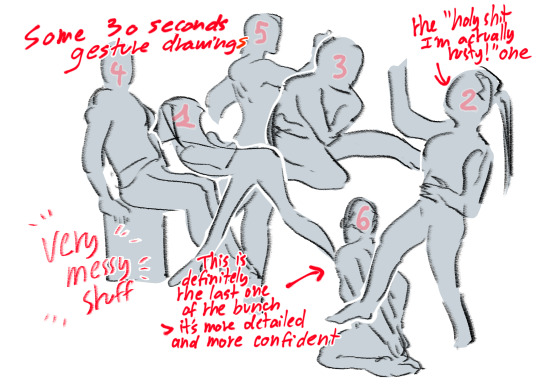
That's great we are talking about a lot of technical stuff. But what about the actual drawing you want to do? Well first, you need to decide which feeling you want to convey. Is it a scary scene? A gentle one? What do you want to depict? Is there something in particular you want to focus on? Something is needed to act as the solid base and this applies to everything, not only posing. Let's take a look at some examples with what we have seen with force lines and see more of the thought process behind my own poses.
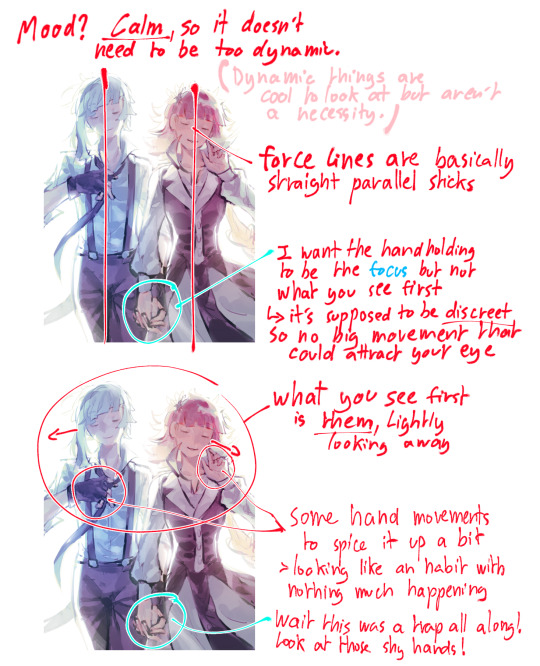
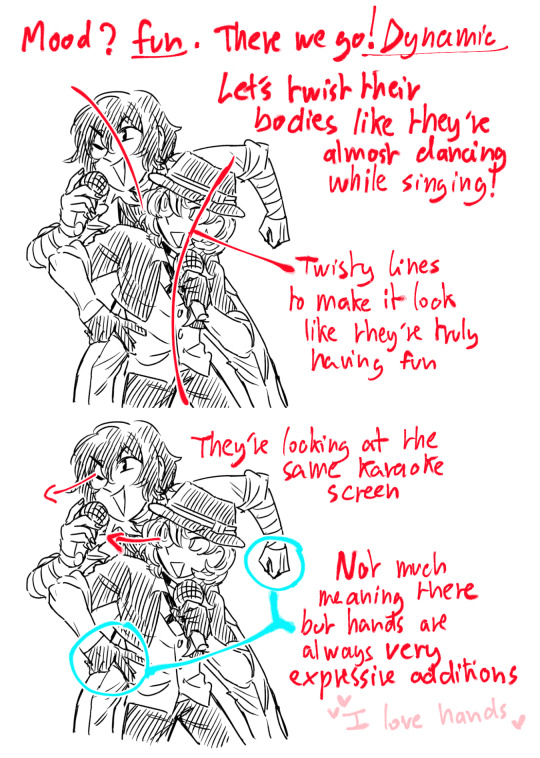
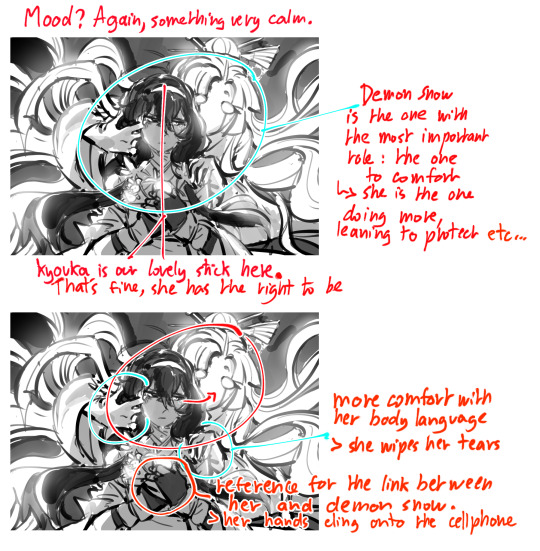
And that's about it of what I'll tackle in this single ask ahah. This is basically a lot of brainstorming and thinking as well as taking inspiration from how real life people move, especially when it comes to body language. I took it a bit too seriously but I do hope it was of some help!
164 notes
·
View notes
Note
i remember a while back you saying in one of these asks that you didnt find classpects that interesting as a writing tool (or something similar, i don’t remember the exact wording) but you seem to be referring to them significantly more since then, both textally in godfeels and when you’ve discussed the work like in these asks - has anything changed in your perspective on them?
astute observation!
so, i don't find classpects particularly interesting as a writing tool. i'm not a big fan of mapping out a character beforehand, engaging in that sort of reverse personality quiz process of defining their wants, their needs, their astrological sign, etc. no hate to anyone who does, but for me it's far more interesting to just let the character decide that stuff for themselves. it's the same process of discovery i apply to the rest of godfeels, which is admittedly a sort of insane way to work and probably shouldn't be taken as an example.
so that's a very specific definition of "writing tool" that maybe isn't what other people are thinking of. i can get didactic about these things because i don't like writing advice or things that seem like writing advice if you squint.
you're right though that classpects are more at the front of my mind than they used to be. part of it is just that classpects are about to be a lot more actively relevant to the narrative (albeit not in the way you would expect), so i've obviously been thinking about them more. which, you know, those thoughts do naturally generate fiction activity which shapes how i intend to write future chapters-- in that sense, are classpects not a useful "writing tool" for me? i dunno.
it's not even that i find them more meaningful structurally. i think giving someone a title and then building their character around it is a great way to come up with wooden characters. in the case of the upsilon kids (who you will be meeting very soon), their classpects emerged through writing a bunch of little test scenes. i'd put them in a room together and give them something to react to. i really want to avoid conventional group dynamics with this crew, so i always pushed them to behave in messy ways. and over time it became apparent that what makes them work is their seeming incompatibility, which i shouldn't say much more about until you've actually got some material to draw your own conclusions from. but the point is, it wasn't until i got a good handle on each kid's vibe that i assigned them their classpects, and i assigned them in a way that was deliberately "underwhelming" or seemingly a bad fit. i did this because i don't like the narratological determinism that can arise when you give a character a title they like too much.
i don't like giving writing advice but i highly encourage young writers out there to not be afraid of writing unusable scenes. it helps to be able to think of the writing in the early planning stages as, in some sense, disposable. because the prose isn't the point-- it's getting to the characters as you understand them. there's so many scenes i've written that will not make it into godfeels proper without significant alteration if at all! and look, i know how it is when you feel like you can barely write, so every word you manage to get on the page is precious and needs to be preserved towards the Final Product. sometimes that's correct! precious things always emerge in this process. but it's nowhere near as many as you think, and the hard lesson is understanding the difference between precious and enjoyable. just because you enjoy the thing doesn't make it right for the story. even pretty trash belongs in the bin eventually.
but again, it isn't wasted work. the words aren't the goal, they're just a happy accident. the real work happens in your head.
uh shit anyway so for instance Dana Straten's classpect is Knight of Mind. i must admit she's an outlier among the upsilons in that i picked her classpect in the gf3 prologue with an understanding of her character that was vastly different from who she would end up becoming. back then all i knew about the upsilons was they'd be Dana, Jade's as-yet unnamed daughter, and two others. for a long time, once Julia came in and really breathed life into Dana, i was convinced that Knight of Mind was just wrong. it was a bad choice for her, it didn't make sense, she should have been something else that had cooler power implications and i should just retcon it to something better before anybody notices. this worry resulted in a lot of conversations with my collaborators, ultimately concluding that it was more fun to just play with the hand i'd unwittingly dealt us. so we took the Dana we felt and asked her what Knight of Mind meant to her, figuratively speaking. wrote some scenes, had more conversations. Julia and i have spent a LOT of time discussing Dana's whole situation.
the thing about this is that i don't think our idea of her changed all that much between when she came into her own in like march/april 2021 and when she properly entered the story in summer 2022 (god it feels like that gap should be a lot longer, but i double checked and it's right). much of what we already implicitly understood about Dana remained true. but through our discussions and test scenes, we were able to define those truths in some really useful ways. it was through this process that we textually solidified Dana as someone who doesn't have cool powers, at least not flashy ones anyway. Dana's weapon is her mind-- the ability to use her razor sharp clarity of perception to act on many different forms of knowledge at once. she's not a mind control person, she's not a seeing all eventualities person, she's just a really smart punch person. Knight of Mind, it turns out, was perfect for her, because she doesn't need it. and that realization was very much why i tried to create a similar dynamic with the rest of the upsilons.
so again we ask, does that not make classpects a useful "writing tool" for me? again i answer, i dunno. i don't really care. it's just the process to me. all of it is just the process.
maybe that points to why i was so free with referring to Rose in short as Seer of Mind in that ask. having reached the endpoint of Rose's role in this story, i finally understand what Seer of Light means for her (in godfeels, at any rate). it's that she saw the truth of how the narrative was changing and accepted that it wasn't for her. as in, she saw the light at the end of the tunnel and chose to walk towards it. it's become a shorthand for Rose, you see? i say "Seer of Light" the way i say the name of a friend who was really more of an acquaintance realistically speaking, like we only hung out a couple times a few years ago, but we hit it off so well every time that i was always like "man, i wish we could hang out all the time, we'd be great friends" but just, for one reason or another, it never quite lined up for that to happen. the name of a beloved missed connection, perhaps...
i guess, basically, to put a bow on this: i try not to think about classpects until the character in question is real enough in my mind that they define it rather than the other way around. once again i have no idea if this makes any kind of sense procedurally or if i'm just making my life harder by being stubborn. but then again, the only writing advice any writer can ever give you is how to write the things they already wrote, so
#sarahposts#godfeels#homestuck#rose lalonde#classpects#classpect analysis#seer of light#knight of mind#dana straten#writing advice#i hate writing advice#yet i give it anyway#sarah zedig the hypocrite supreme#of course there's nothing i'd rather be#except maybe financially stable enough to be able to work on godfeels full time#that'd be pretty cool i think
42 notes
·
View notes
Note
I have this wip of an au I wanted to write and I want your thoughts, it's an AoiKane au where Akane is a full supernatural and one day when he stopped the big clocks time (causing the school's time to stop) to look at Aoi she doesn't stop and instead sees him and at first he excited but than realizes that this is because of her short lifespan and soon the severance will happen so we will go off from the actual manga but changing the story to fit the characters new roles, Nene is still Hanako's assistant clock keeper arc still happened ect except it's been altered and I wanted to do this and give a more angsty ending where Aoi doesn't make it back like in the current but Akane still wanders the far shore for her or something? thoughts? advice?
I love full supernatural Akane! And I haven’t seen one for Aoikane, so I’m intrigued. People rarely talk about the big clock that controls the school’s time despite it being No.1’s rumor so is cool to play with this concept too!
As for advice, it depends on your plans.
If you want a relatively short fic, one to three chapters, I recommend focusing on specific scenes you want to write (like Akane lingering when Aoi is already gone, and his grief, or the moment Aoi sees Akane and he realizes she will die) and build up to those scenes, like mentioning a short scene of Akane lingering by the school gate to show he has always been bad at letting her go, or something. No need to try to explain role changes, or expand much on how canon changes or anything, leave things unanswered, just work on making a scene pack a punch.
If you want a multichapter story to explore this idea in more detail, it’s more tricky, cause too much information is hard to juggle around without contradicting yourself eventually and people have different ways that work well for them, so I can only give you advice by how it personally works for me: If you’re stuck for details, or feel like a plot point come out forced, try the ‘butterfly effect’ and go from there, because it’s a pretty fun way to mess with canon, but still have some kind of structure.
Let me give an example where you can apply the butterfly effect and go as deep or lightly with it as you want: You said the clock keeper arc still happens and nene is still Hanako's assistant, so Akane knows Nene, likely even before Hanako knew her, since he is attached to Aoi and Nene would easily be her best friend without a human Akane. You can make them chat from time to time like canon but more comedic since nene would ‘talk to air’ when she talks to Akane, keep it as charming but not that important to the overall fic, or you can create an entirely new dynamic from it, since nene is a way to ‘directly’ interact and communicate with aoi even when she could not see him.
The can even be new arcs from such a small difference: Nenes could absently talk about Akane to Aoi, like she does about hanako, and make her aware of Akane before even seeing him. It can be anything! The fun of it is that you can make your imagination run wild. How close will akane get with aoi? Will she still want to ‘discard’ Akane on the reapers arc since they don't have as much 'history' together? is Aoi herself a different person since Akane wasn’t part of her life? Does stopping the school clock have any consequences for Akane?
Just ask questions and go crazy, a lot of times you can reach where you want by a different means from canon entirely.
(I just realized i have been assuming Akane is a full supernatural that haven’t met aoi while alive, but even if that’s not the case, there is still many questions to be asked.)
#i love your comcept!#good luck writing this au#I'm not very good at advise but these personally work really well for me!#so i hope something here helps you too
15 notes
·
View notes